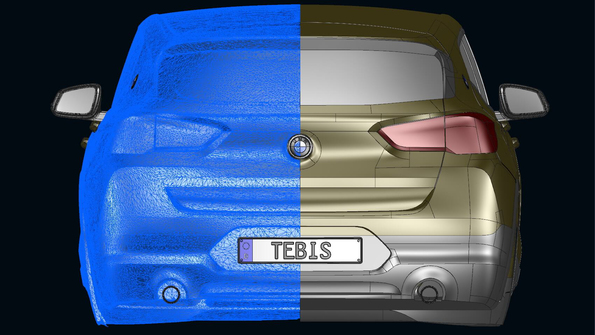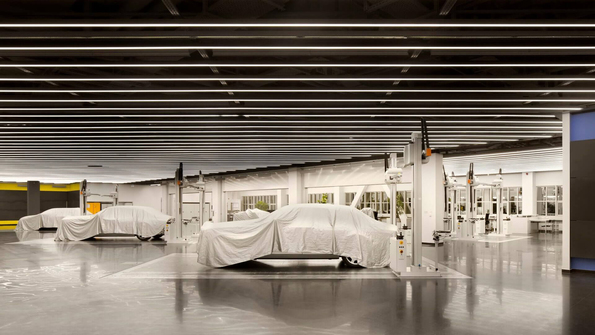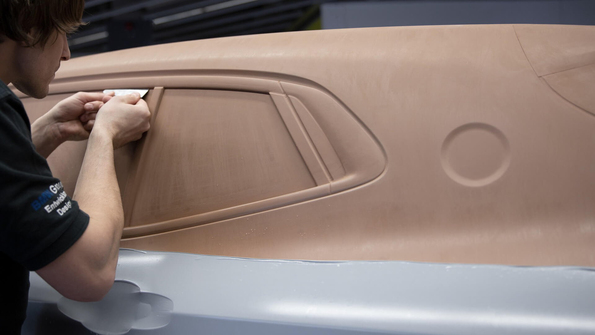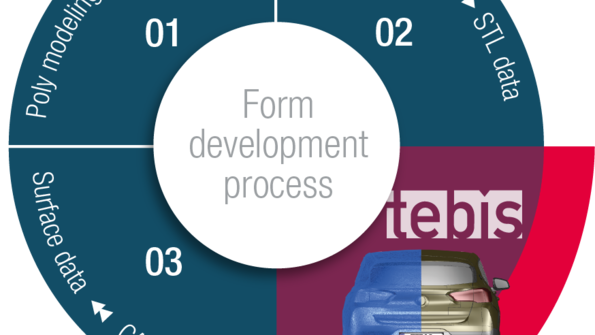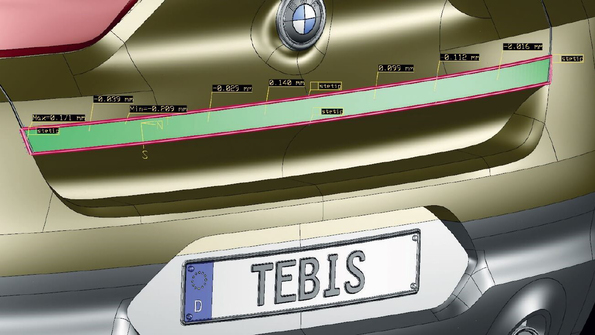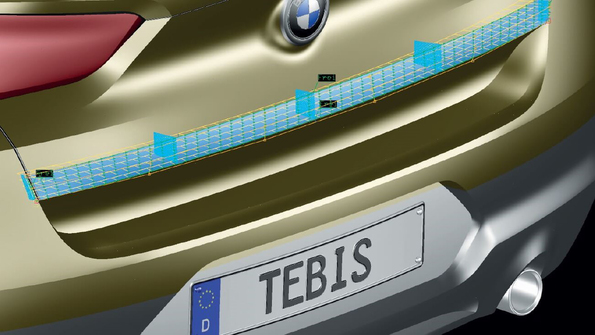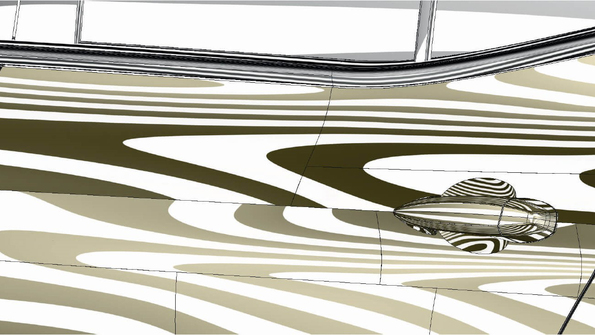-
Software
-
CAM software
- Tebis Automill
- CNC programming
- CNC automation
- CNC simulator
- Multiple setup
- Robotic machining
- CNC drilling
- Deep-hole drilling
- Combined turn-milling
- CNC turning
- Turn-milling
- 2.5D milling
- 3D milling
- 5-axis milling
- Slot milling
- Trimming
- HPC milling
- HFC milling
- Circle-segment cutters
- Sinker EDM
- Wire EDM
- 3D laser cutting
- Laser hardening
- Laser weld cladding
- CAD software
- CAQ software
- MES software
- Products
-
CAM software
- Services
- Consulting
- Sectors
- References
- Company
- News

-
 Home References
Home ReferencesBest practice for consistent design:
Reverse engineering with Tebis
In cooperation with BMW Group Design, Tebis has developed reliable methods to combine form development by manual and virtual design as effectively as possible.
Company
BMW Group
Location
München, Germany
Focus
Digitized data processing, Reverse engineering, Surface quality, Design development
Benefits:
- Quickly generate high-quality surfaces from digitized data of design models
- Surface data always available in form development process
- Simple handling and cost savings
Sector
Automotive
Model making
Published
2019


For a model of medium complexity, developing high-quality CAD design surfaces for the outer skin of a vehicle now takes roughly 50 hours. (Previously, it took about twice the time.)
BWM Group-DesignWe are working on fast surfaces in cooperation with BMW. We want to go from the current average of 25 hours of work for design surfaces to 10 hours for surfaces that are good enough for initial investigations. We are extremely confident that we will achieve this goal together.
Eckhard Metzger, Product manager at TebisTebis reverse engineering in Practice
Tebis 4.0, on the market since 2015, includes all the design functions developed in cooperation with BMW Group. Be sure that your company benefits as well.
The precise and fast transfer of physical vehicle models into the virtual world is an important success factor in design.
In cooperation with BMW Group Design, Tebis has developed reliable methods to combine form development by manual and virtual design as effectively as possible.Developing the form for a new vehicle requires not only ideas and creativity but also special methods and software. At the BMW Group, creative designers generate both a computer model of a new vehicle as well as a physical one. Using a tangible object is the best way to evaluate and further develop the form. Tebis reverse engineering is used to transfer the clay model into the virtual world and make the data available for further process steps. The virtual data obtained from the real model is necessary for aspects such as high-end visualization—the basis for the final decision on form.On the road to a new form
Today, designers typically use modeling to first create the desired form of a planned new vehicle in 3D space. 2D sketches and 3D surface data are generated on screen. This data serves as the basis for physical models that are usually made of clay (industrial plasticine). The clay models are used to develop the final form and establish the design. After evaluating the design, designers and modelers change the proportions and forms.Tebis: Roles in the design process
A processed, finalized clay model is always digitized. The result is digitized data. At this point, Tebis becomes the tool of choice: The imported digitized data in STL format can be used on Tebis workstations to quickly generate the surface data for further process steps. Tebis provides high-quality CAD surface data at two quality levels: Engineering surfaces and design surfaces. The excellent design surfaces have pre-class A quality and are used, for example, for the 3D visualization required for photo-realistic images and videos of the virtual 3D model. These high-quality surfaces can be further processed directly in CAS systems and acquire their final class A quality there. Engineering surfaces are generated as a preliminary stage of the design surfaces in roughly half the time. These have lower quality in terms of surface streamlining and are exchanged with departments such as Body, Chassis and Drivetrain.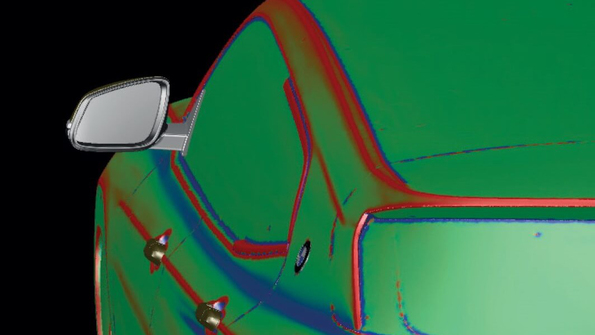 Experts in the studio use color analysis to quickly recognize convex and concave areas in the surface model and design their future surface layout
Experts in the studio use color analysis to quickly recognize convex and concave areas in the surface model and design their future surface layout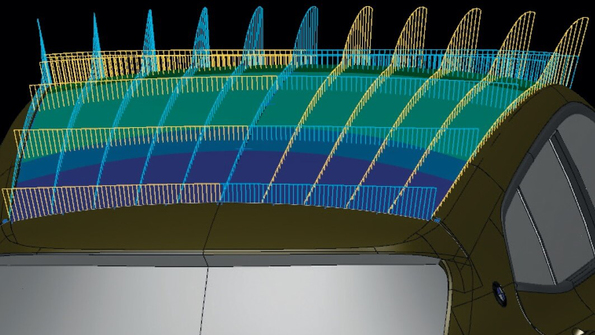 The design studio uses various Tebis curvature diagnosis functions to evaluate the surface quality of the reverse-engineered surfaces.The time factor in reverse engineering
The design studio uses various Tebis curvature diagnosis functions to evaluate the surface quality of the reverse-engineered surfaces.The time factor in reverse engineering
The timeframe between initial concept and market introduction of new models is becoming shorter and shorter. At the same time, design plays an enormous role in the automotive industry; it must be appealing, striking, innovative and in line with the brand. Although using clay models contributes to the required design quality, valuable time is lost in the form development process. In cooperation with the BMW Group, Tebis has generated high-quality design surfaces in shorter and shorter times over the past two decades. Processing time was halved from 2010 to 2013 alone. The basis for this was a joint project whose objective was to invest only 50 hours instead of 100 hours to achieve the best-quality reverse engineering of a vehicle exterior.New methods: Major benefits for users
Among other things, the project focused on a new tolerance-controlled approximation method as well as fully automatic curve synchronization. Tebis placed special emphasis on the time-intensive manual reconstruction of the theoretical edges. The most time-intensive steps in the process were eliminated by new algorithms. The user interface was also scrutinized to make access easier for beginners. The project was successful, as the numbers clearly show. For a model of medium complexity, developing high-quality CAD design surfaces for the outer skin of a vehicle now takes roughly 50 hours. If CAD design quality is adequate, such as for investigating installation aspects, only 25 hours are needed. The benefits for users: Significant cost savings; simple handling in reverse engineering; continuous, timely data for high-quality CAD surfaces throughout the form development and clay modeling process.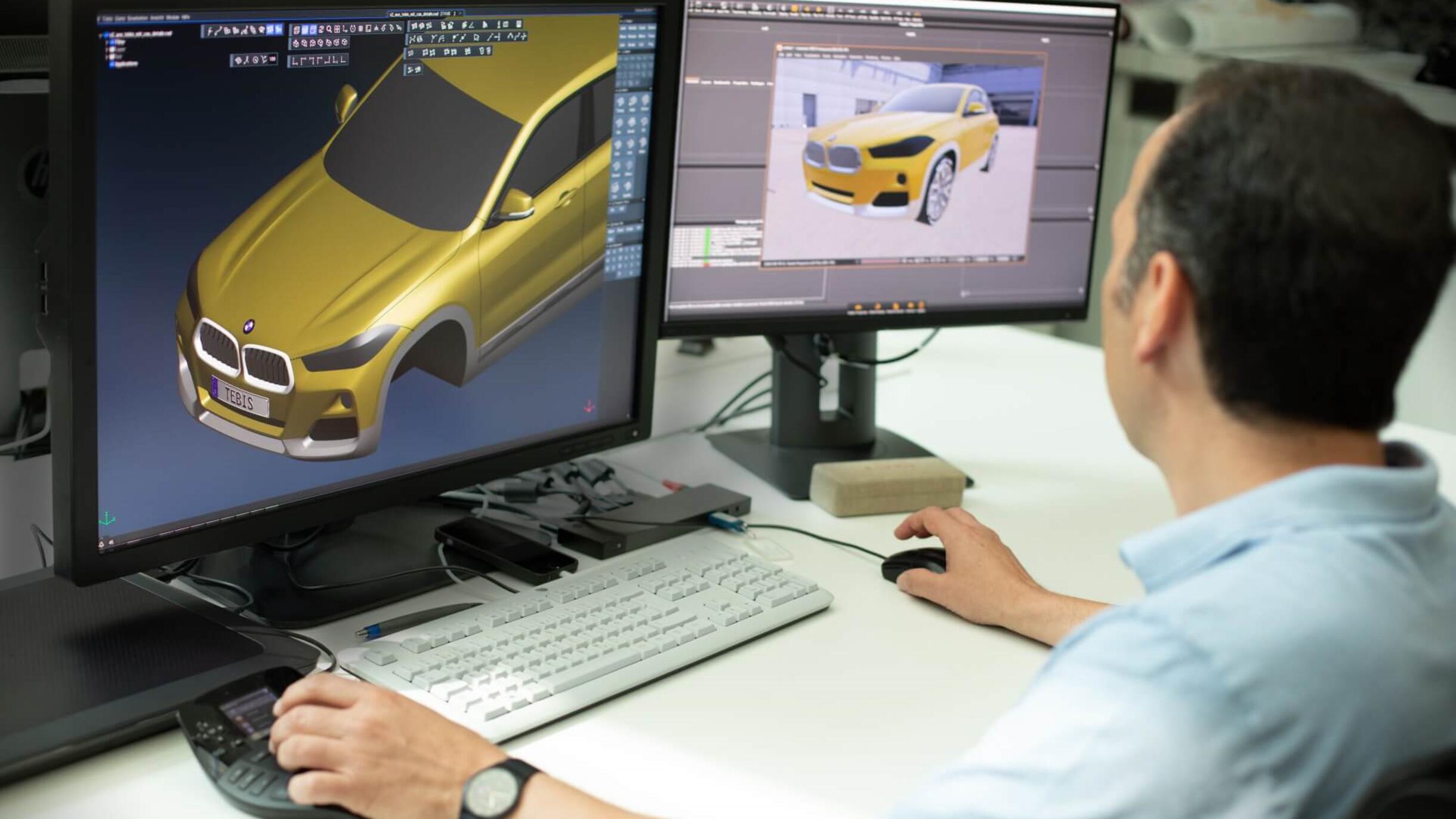 The renderings for the BMW X2 are prepared in the tool for work visualization (right screen) based on the surface model generated in Tebis (left screen)
The renderings for the BMW X2 are prepared in the tool for work visualization (right screen) based on the surface model generated in Tebis (left screen)New methods: Development from practice
Tebis benefited from the practical software development and testing of the prototype in the actual work environment. In 2015, Tebis officially released the software prototypes used by the BMW Group in Version 4.0. Since then, all Tebis customers can generate their surfaces twice as fast based on meshes and adapt them to theoretical edges, a prerequisite for acceptance of the surfaces in subsequent processesTheoretical edges are automatically retained in Tebis during reverse engineering and surface modeling. Special functions are available in the software to quickly generate theoretical edges.Tebis is currently working with the BMW Group to further automate surface calculation. "We want to speed up surface design," says Tebis product manager Eckhard Metzger, explaining the vision.
"We want to go from the current average of 25 hours of work for design surfaces to 10 hours for surfaces that are good enough for initial investigations. We are very confident we can reach this goal."
Milestones for maximum benefit with low effort
Since approximately 1990 Virtual design increasingly implemented in the automotive industry, often in parallel with clay models. Problems: Large time investment to digitize a model, enormous data volumes, milling on meshes. 1996 Tebis digitized data processing implemented by the BMW Group to improve the digitization process. Benefits: Shadable polyhedra, visual checking of scanned surfaces, detection and correction of errors in the CAD surface model. 1997 Individual surfaces based on digitized data possible with Tebis surface approximation. Benefits: Optimizing surfaces, closing holes, creating base surfaces. About: Smooth transitions to adjacent surfaces are still through the standard CAD system—a time-intensive step compared to the present. 1998 Digitized data processing with Tebis optimized—for process steps with meshes without surfaces, exchange via STL format. Benefits: Functions for trimming, data reduction, filling holes, extending areas, etc. 2003 Tebis software prototype for reverse engineering introduced. Benefits: PC-based solutioPC-based solution, less technology at the workplace, surface data instead of digitized data, data volume significantly reduced, no replacement of cuts. But: Two to three weeks of work time still required for the highest-quality surfaces. 2005-2008 New Tebis modules implemented. Advantages: Creation of individual surfaces with transition conditions to adjacent surfaces without detour via standard CAD; higher-quality surfaces optimally usable for further phases in the development process. But: Time required for highest quality: Average time to reverse-engineer for exterior 70 hours, for highest-quality surfaces 120 to 125 hours. 2009 Tebis BREP family: Modules for reverse engineering developed by Tebis in close cooperation with BMW combined in a software package. 2010-2013 Project to improve clay process quality. Result: Halved the time required for highest-quality reverse engineering of a vehicle exterior. 2013-2015 Time for reverse engineering further shortened and process extended to new areas, new functions continually developed and improved. Since 2015 Reverse engineering with Tebis is the standard</236><237> in exterior design at the BMW Group. Tebis 4.0 released with all design functions developed in cooperation with the BMW Group.


